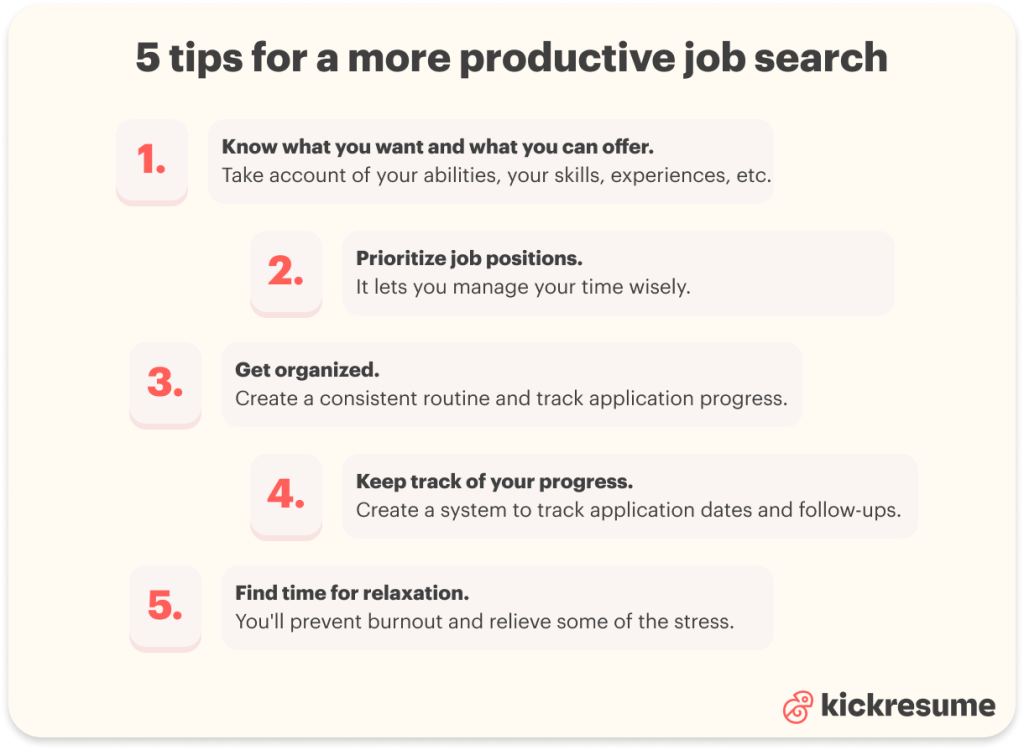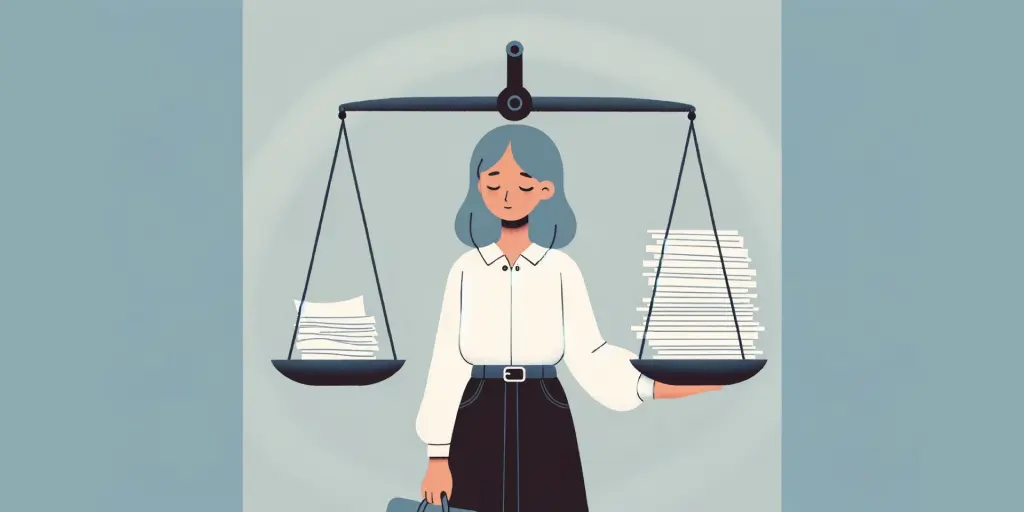The process of job searching can often feel like an uphill battle. One way of making things easier is to answer the question "How many jobs I should apply for?"
Our recommendation? To make your job hunt effective yet manageable, you should be prepared to apply for approximately 2-3 jobs a day, or 10-15 jobs per week.
This isn't just a guesstimate, our conclusions are based on research-backed data. By sticking to these numbers you won't have to sacrifice quality for quantity; nor will you do too little to land you a job interview or two.
Keep on reading to also find:
- What does the current job market situation look like;
- Why are 2-3 applications a day the optimal number;
- What does a good job application consist of;
- Whether you should apply for multiple jobs at the same company;
- How to make your job search more productive.
- How many jobs should you apply for (and why)
- How many jobs should I apply for a day?
- How many jobs should I apply for a week?
- What does a "job application" consist of?
- Advantages and disadvantages of sending multiple job applications
- Applying to multiple jobs at the same company: yes or no?
- How to make your job search more productive?
- Key takeaways: How many jobs should I apply for?
How many jobs should you apply for (and why)
How many jobs should you apply for when embarking on your job search journey? Let's cut to the chase: the magic number is approximately 2-3 applications a day, or 10-15 applications per week.
This recommendation isn't just plucked out of thin air. It's backed by solid data and research.
Now, let's look at why you should apply to 2-3 jobs a day.
Finding a job can be tough, especially when you consider that in 2023, recruiters received about 250 applications for each job they posted, according to a Zippia study. But only a handful of applicants get the chance for an interview.
The tricky part is that recruiters often have different opinions on who's the right fit. They can be quite subjective and inconsistent in assessing potential employees.
In fact, a recruiter study by Kickresume found that even when shown the same resume twice (without them knowing it), their decisions were inconsistent, especially when it came to suitable candidates.
So, what's the takeaway for job seekers? Even if you perfectly match a job's requirements, landing an interview isn't guaranteed. That's why the strategy of applying to multiple jobs at the same time comes in handy.
But here's the catch: Having read the above, you might think that applying to only 2-3 jobs daily isn't enough.
However, consider this data from Zippia: The most successful job seekers applied for 21 to 80 jobs in total, taking about two to three months to land a job, with a 30.89% chance of receiving an offer. Surprisingly, those who sent out over 81 applications reduced their chances by more than 10%. And job seekers who applied to just 11-20 job postings were only slightly less successful, with a 29.48% success rate.
Strangely enough, sending out too many applications can actually lower your chances of getting hired.
Why is that? Here's the deal: When you focus on quantity over quality in your job applications, you end up with less time and energy to make each one stand out.
Conclusion: Applying to 2-3 jobs a day strikes the perfect balance. You increase your chances of landing a job by sending multiple applications at once, while not compromising the quality of each application.
How many jobs should I apply for a day?
The magic number is 2-3. Applying to 2-3 jobs a day strikes the perfect balance. You increase your chances of landing a job by sending multiple applications at once, while not compromising the quality of each application.
For the best results, send your applications before 8 am. You want to be among the first candidates they see.
How many jobs should I apply for a week?
When it comes to how many jobs should you apply for a week, aim for about 10-15.
But here's a tip: Monday is your golden opportunity. The later in the week you send your applications, the lower the chances of them getting noticed.
So, make it a habit to send your applications very early on a Monday morning for the best shot at catching employers' attention.
What does a "job application" consist of?
Submitting a job application is one thing. Submitting a really good application is quite another.
We've previously looked at how many jobs you should apply for. However, no matter how rigorous you are with sending your applications – if it's bad, you could send a million and not hear back.
True, recruiters may not be able to agree on what precisely makes a good candidate. But they can easily recognize a bad job application when they see one. Besides, it's not uncommon for companies to use ATS (Applicant Tracking System). This means that poorly executed applications will be dismissed even before reaching human eyes.
And that's precisely why a good job application should include:
- Resume. Present your most relevant work experience, skills, and education. And ALWAYS tailor it to each job.
- Cover letter. Show the recruiters who you are and make them want to read your application.
- Email. Well, the email is how you actually apply (more on what to write in it later.)
Let's look at each of the three components in more detail.
1. Resume
While a resume is a vital part of any job application, there is no one-size-fits-all principle to follow.
The key to a successful resume (and by extension a successful application) lies in tailoring each resume to a specific job description.
Here is a brief how-to for tailoring each resume:
- Prepare a generic resume. It's a good idea to always have one at hand. It'll be the starting point from which you can then craft a more tailored and detailed resume each time you apply for a different job.
- Review the job posting. Identify the recurring keywords, job requirements, key hard and soft skills.
- Use the keywords. Make sure you incorporate the keywords into your resume. Their absence can be the reason why your application won't get past the ATS.
- Select a suitable design. Pick a design which suits the company's culture. More conservative companies tend to prefer classic-looking resumes. If you're applying for a position in a creative field, recruiters might appreciate bolder resume templates.
Tailoring each resume can be a tedious process. Luckily, tools like AI Resume Writer make the process faster and simpler since AI does all the work for you.
2. Cover letter
If you're still struggling to receive an invitation to job interviews, not attaching a cover letter to your application, or attaching a really poor one, can be the reason why.
Think of the cover letter as your personalized introduction to the recruiters. They'll most likely read it before looking at your actual resume.
It's the perfect medium to make you stand out from the rest of the applicants. Therefore, it's in your best interest to make it as memorable and eye-catching as possible.
To write a good cover letter you'll need to:
- Research the company you want to work for (What exactly is the company looking for? What are their latest endeavours?)
- Make your writing specific and focused
- Highlight your best qualities and professional achievements
- Tailor each cover letter to the exact needs of your target company
- Our AI Cover Letter generator which basically writes the first draft for you
If you've never written one before and want to learn more, we've got you covered! (a pause for laughter). This ultimate cover letter guide offers comprehensive information on everything you need to know about cover letter writing.
In short, the content of your cover letter should show the recruiters:
- who you are professionally;
- what is your personal motivation for applying for this particular position.
- what experience and skills you possess that make you and ideal candidate;
- why you're interested in working for their company;
Additionally, if you're fresh out of school, this step-by-step guide on how to write a cover letter with no experience will show you what to focus on instead.
3. Email
Once you've finished putting together your resume and cover letter, you will probably have to send your application via email.
When you're competing for recruiters' attention with 250 other people, sending your “Hello, I'm sending you my resume. Goodbye.” email simply won't do!
You have to treat the contents of this email as another opportunity to showcase your professionalism.
The are two good strategies for what to write in an email when sending a resume to an employer:
- Treat the body of the email as a cover letter. Basically, instead of attaching a cover letter, write it in the body. This forces the receiver to read your cover letter.
- Write a short version of your cover letter in the email body and attach the full cover letter as a PDF. This short version should include:
- Subject. Start with a subject line that indicates the purpose of the email. Make sure to also state your name, like so: “Job application – Accounting Manager — Thomas Rounded“
- Salutation. Greet the recipient of your email appropriately.
- Introductory paragraph. Introduce yourself and the contents of your email.
- Main paragraph. Here, briefly mention your professional achievements. Make sure you don't copy your cover letter word for word.
- Closing paragraph. Let them know you're looking forward to hearing from them.
- Sign off. Use either “Yours faithfully,” or “Yours sincerely,”.
Moreover, you can draw further inspiration from 10 more Job Application Email Templates that are ready for you to copy and paste. No hassle.

Advantages and disadvantages of sending multiple job applications
Confession time.
Yes, we've told you that applying for 2-3 jobs a day/ 10-15 a week is the optimal number to land a job quicker. But the truth is this – there is no magical number that would fit all.
Our calculations are based on a study that reflects the average results. These results may not fit your specific circumstances.
There are several factors to consider:
- Your current employment status. If you're unemployed, you probably have plenty of free time on your hands. You may be able to apply for more. On the other hand, if you're trying to balance a full-time job and family commitments alongside your job search, applying for 2 jobs a day may be unfeasible.
- The degree of your specialization. The more specialized your skills are, the less competition you'll have to face. But there will also be less open positions to apply to. For example, an architect specializing in high altitude buildings won't be able to respond to as many job postings as someone looking to secure a position in retail.
- The level of your experience. If you've years of experience and professional results to show, it won't be difficult for recruiters to recognize you as a valuable employee. Your job search will be successfully over pretty quickly. But if you're just starting out or want to change careers, you'll probably have to respond to more job postings to get noticed.
Advantages
Naturally, sending out more than 2-3 job applications per day has its perks, such as:
- More opportunities. Logic dictates that the more applications you send, the bigger your chances of securing a job are. To a certain degree, this is true. But, as mentioned before, prioritizing the quantity of your applications often hinders their quality. Keep this in mind if you aim to apply for more postings.
- Practice. To put together a good job application is a serious skill in itself. And as with any other skill, practice makes perfect. At first, writing and tailoring your resume and cover letter will take you what feels like forever. Given the recruiters' subjectivity and inconsistency, job hunting may often come down to a process of trial and error. But with time, the whole process will become easier for you.
- Getting acquainted with the market. Whether you realise it or not, by reacting to multiple job postings, you're learning a lot about the industry of your choice. You can gain a firm grip of what certain positions entail and what skills and knowledge are the most in demand. Besides, your research may lead you to get a closer look at several competing companies. This will give you a deeper understanding of the newest trends and developments in your field of interest. All of this useful information can serve you well if you get invited to a job interview.
Disadvantages
Sending out multiple job applications can be a double-edged sword. Some of the risks include:
- Lower quality of applications. A good application takes personalisation, research and time. We've said it once and we'll say it again: The more applications you send; the less time you'll have left for their execution. By submitting a poor application, you're self-sabotaging.
- Burnout. Trying to get employed is a marathon, not a sprint. Don't exhaust yourself too early. Many'll feel the need to respond to as many job postings as quickly as possible. While this may work for a day or two, it's by no means sustainable. Remember, it may take several weeks or months until you finally get a job offer.
- Increased stress. Yes, job uncertainty is stressful. But sending 7-10 half-baked job applications daily and not hearing back from any of them may be even worse. To make up for the lack of results, you may feel pressured to send even more applications - and so the cycle repeats itself. In the long run, additional strain on your mental health can also negatively impact your overall physical health.

Applying to multiple jobs at the same company: yes or no?
Applying to multiple jobs at the same company is a smart move, but with a caveat. You should only apply to multiple positions at the same company if the jobs are somewhat similar, and you possess relevant expertise for both roles.
In your cover letter, be sure to address why you're applying for both positions, emphasizing your unique fit and enthusiasm for each role. Tailoring your applications in this way can significantly increase your chances of success.
This approach demonstrates your genuine interest and adaptability within the organization.
How to make your job search more productive?
Now that we've shown you both the positive and negative side of applying to multiple jobs at once, it's time to talk about steps you can take to make the process more effective.
Here are 5 tips:
#1 Know what you want and what you can offer
Instead of casting the widest net possible and crossing your fingers for good results, take a more deliberate approach.
Take account of your abilities, your skills, experiences, etc. Try to be as objective as possible. You can ask a friend to help you identify your strengths and weaknesses, or ask for feedback from your ex-colleagues.
Once you know what you can offer as an employee, make a mental check list of the things you expect from your employer. Where are you willing to make compromises? What boundaries are you not willing to cross?
Organizing your thoughts before you start the actual job search will save you time and energy you would otherwise spend on jobs you're not really interested in.
#2 Prioritize job positions
Keep in mind that you always need to tailor each application to the exact demands of a specific job. This is quite the process and time is of the essence.
Not every job application you send will be perfect, and not every application needs to be perfect. But they all need to adhere to a certain standard!
Once you've found 3 or 4 job postings, organize them into a list based on your preference. This will help you allocate your time and energy accordingly.
It would be nonsensical to waste hours trying to perfect an application for a job that you see just as a back-up plan.
#3 Get organized
When it comes to job searching, as with any other long-term projects, consistency is key.
Make a plan that best fits your circumstances.
For example, check job boards (or job search engines) for new postings the first thing in the morning. If you have time, start putting together your applications. If not, save the posts and return to them in the afternoon. Repeat.
Generally speaking:
- The sooner you react to a job posting, the more likely you are to get noticed. Majority of recruiters adhere to the first come, first served principle.
- Prioritize newer postings over those with an older date.
#4 Keep track of your progress
Create a system to track application dates and follow-ups. You can put your Excel skills to good use.
When you send multiple job applications, you're running the risk of forgetting which postings you've already responded to.
You can also mark down:
- which applications were successful (you were invited to a job interview);
- which weren't (you were sent a rejection letter);
- and which ones deserve a follow-up email.
#5 Find time for relaxation
Our final tip is... relax!
Try to find time for yourself and decompress. Go for a walk, read a book, exercise. You'll prevent burnout and relieve some of the stress you're experiencing at the moment.
Plus, spending time with your friends and family may give you a different perspective on your current situation. Talking to people always helps.
Key takeaways: How many jobs should I apply for?
When looking for a job, the optimal number of applications you should send is 2-3 a day, or 10-15 per week. Keeping to this range will make your job hunt manageable and effective.
So, to answer the question "Should i apply to multiple jobs at the same time?" Yes, you should. However, the quantity of your job applications should never overshadow their quality.
On one hand, sending more job applications can bring you more opportunities for success; more space for practice; and market insights. But it can also lower the quality of your applications; be a potential cause of burnout; and increase your stress levels.
A well-rounded job application consists of: a tailored resume, a compelling cover letter, and a professionally written email. Each of these presents an opportunity to make a lasting impression on the recruiters. It takes time and considerable energy to execute them well.
Finally once you do land an interview, don’t forget to prepare answers for common interview questions like:
Tools like Kickresume's Interview Questions Generator can also come in handy. This AI-powered tool tailors common interview questions to your industry and role, ensuring you're well-prepared for any interview scenario.



